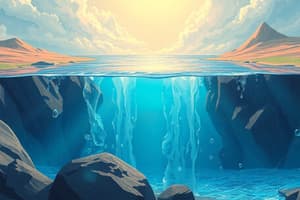Podcast
Questions and Answers
What is the primary factor that provides energy for evaporation?
What is the primary factor that provides energy for evaporation?
- Solar radiation (correct)
- Wind
- Humidity
- Temperature
Higher humidity increases evaporation rates.
Higher humidity increases evaporation rates.
False (B)
What is the term for the temperature at which air becomes saturated with water vapor, leading to condensation?
What is the term for the temperature at which air becomes saturated with water vapor, leading to condensation?
dew point
Water droplets that form on surfaces are known as ___________________.
Water droplets that form on surfaces are known as ___________________.
What type of precipitation occurs when raindrops freeze before reaching the ground?
What type of precipitation occurs when raindrops freeze before reaching the ground?
Cloud type does not affect the type of precipitation that occurs.
Cloud type does not affect the type of precipitation that occurs.
Match the following types of precipitation with their descriptions:
Match the following types of precipitation with their descriptions:
The process by which water vapor in the air is cooled and changed back into liquid water is called ___________________.
The process by which water vapor in the air is cooled and changed back into liquid water is called ___________________.
What is the term for the process by which mountains and hills force air to rise, cool, and condense, resulting in precipitation?
What is the term for the process by which mountains and hills force air to rise, cool, and condense, resulting in precipitation?
Flashcards are hidden until you start studying
Study Notes
Water Cycle
Evaporation
- Process by which liquid water is transformed into water vapor
- Occurs at the surface of oceans, lakes, rivers, and the ground
- Factors that influence evaporation:
- Temperature: higher temperatures increase evaporation rates
- Humidity: lower humidity allows for more evaporation
- Wind: increases evaporation by facilitating water molecules' escape
- Solar radiation: provides energy for evaporation
Condensation
- Process by which water vapor in the air is cooled and changed back into liquid water
- Occurs when air reaches its dew point (temperature at which air becomes saturated with water vapor)
- Forms:
- Clouds: water droplets suspended in air
- Fog: water droplets suspended near the ground
- Dew: water droplets that form on surfaces
- Frost: ice crystals that form on surfaces
Precipitation
- Process by which water droplets in clouds combine and fall to the ground
- Forms:
- Rain: liquid droplets
- Snow: ice crystals
- Sleet: raindrops that freeze before reaching the ground
- Hail: updrafts in thunderstorms carry water droplets up, where they freeze into small balls of ice
- Factors that influence precipitation:
- Cloud type: different clouds produce different types of precipitation
- Air currents: wind patterns affect precipitation distribution
- Topography: mountains and hills force air to rise, cool, and condense, resulting in orographic precipitation
Water Cycle
Evaporation
- Liquid water transforms into water vapor through evaporation, occurring at the surface of oceans, lakes, rivers, and the ground.
- Temperature, humidity, wind, and solar radiation are key factors influencing evaporation rates.
- Higher temperatures increase evaporation rates, while lower humidity allows for more evaporation.
- Wind facilitates the escape of water molecules, increasing evaporation, and solar radiation provides the energy for evaporation.
Condensation
- Water vapor in the air cools and changes back into liquid water through condensation, occurring when air reaches its dew point.
- Clouds, fog, dew, and frost are formed through condensation.
- Clouds are composed of water droplets suspended in air, while fog is composed of water droplets suspended near the ground.
- Dew forms on surfaces, and frost forms when water droplets on surfaces freeze into ice crystals.
Precipitation
- Water droplets in clouds combine and fall to the ground through precipitation, forming rain, snow, sleet, or hail.
- Rain consists of liquid droplets, while snow consists of ice crystals.
- Sleet forms when raindrops freeze before reaching the ground, and hail forms when updrafts in thunderstorms carry water droplets up, where they freeze into small balls of ice.
- Cloud type, air currents, and topography influence precipitation distribution and type.
- Different clouds produce different types of precipitation, and air currents affect precipitation distribution.
- Topography, such as mountains and hills, forces air to rise, cool, and condense, resulting in orographic precipitation.
Studying That Suits You
Use AI to generate personalized quizzes and flashcards to suit your learning preferences.




